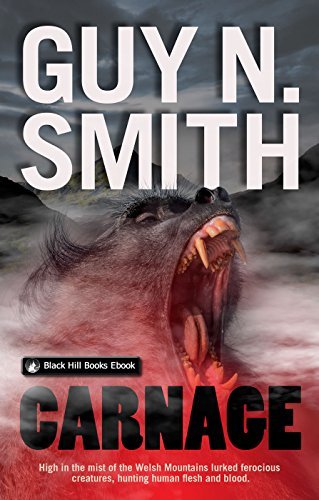
“Carnage” is a horror novel by Guy N. Smith, published in 1976. Known for his ability to create chilling and suspenseful narratives, Smith delivers another gruesome and thrilling story in “Carnage.”
Plot Summary
In a remote corner of Wales, the Lewis family nurtured an extraordinary bond with a pair of baboons, their companions for years within the sanctuary of their secluded home. However, the idyllic harmony was shattered by the mandate of the 1976 Dangerous Wild Animals Act, which imposed exorbitant security requirements beyond their means. Forced to make a heart-wrenching decision, the Lewises clandestinely released their beloved baboons into the rugged embrace of the Welsh Mountains, bidding farewell to their cherished companions.
As time flowed like the nearby streams, the baboons vanished from sight, integrating seamlessly into the natural tapestry of the ancient forests and swirling mists. Unbeknownst to humanity, they carved out a hidden existence, raising their young amidst the whispering pines and rocky crags, a forgotten chapter in the annals of the wilderness.
Yet, four decades later, the tranquility of the mountains shattered with a series of chilling events. The tranquil slopes and winding trails morphed into a realm of peril as climbers and walkers faced an unseen menace. A string of mysterious killings gripped the region, shattering the illusion of safety and transforming the once-peaceful landscape into a realm of fear and uncertainty.
“The Hidden Legacy” chronicles the enigmatic tale of the Lewis baboons, a saga that transcends time and resonates with the intricate dance between humanity and the untamed wilderness. Through its haunting narrative, the film invites audiences to ponder the consequences of our actions upon the natural world, and the enduring legacy of creatures left to forge their own destiny in the shadowed realms of the wild.
Themes and Style
- Nature’s Revenge: “Carnage” explores the theme of nature turning against humanity, with the rats representing a primal force of destruction unleashed upon civilization.
- Survival Horror: The novel is characterized by its intense and suspenseful atmosphere, as the characters fight for survival against overwhelming odds.
- Isolation and Claustrophobia: The setting of a small village adds to the novel’s sense of claustrophobia and isolation, heightening the tension and fear experienced by the characters.
Reception
“Carnage” received positive reviews from readers and critics, who praised its fast-paced narrative, gruesome imagery, and relentless tension. The novel’s effective blend of horror and suspense, along with its memorable portrayal of the rat infestation, made it a standout entry in Smith’s body of work.
Author Background
Guy N. Smith (1939-2020) was a British author known primarily for his horror fiction. With over 100 novels to his name, Smith’s works often feature elements of the supernatural, the macabre, and the grotesque. He is best known for his “Crabs” series, which involves giant killer crabs terrorizing humanity. Smith’s ability to craft gripping and eerie stories has earned him a dedicated following among horror enthusiasts.
Legacy
“Carnage” remains a classic example of Guy N. Smith’s talent for creating visceral and terrifying horror narratives. The novel continues to be appreciated by fans of the genre for its relentless pace, gruesome imagery, and unrelenting sense of dread. Whether readers are new to Smith’s work or longtime fans, “Carnage” offers a thrilling and unforgettable journey into the heart of darkness.
High in the mists of the Welsh mountains lurked ferocious creatures hunting human flesh and blood.
The Lewis family had hand reared a pair of baboons which lived with them for several years in their remote home.
Then came the 1976 Dangerous Wild Animals Act which demanded costly security to be installed. They could no longer afford to keep their pets so they secretly released them in the Welsh Mountains.
Nothing more was seen of the primates but they had reared their young, hidden from humans, in the vast forests and mountain mists.
Then, forty years later, the killings began and the mountains became a dangerous place for climbers and walkers.
Guy N. Smith